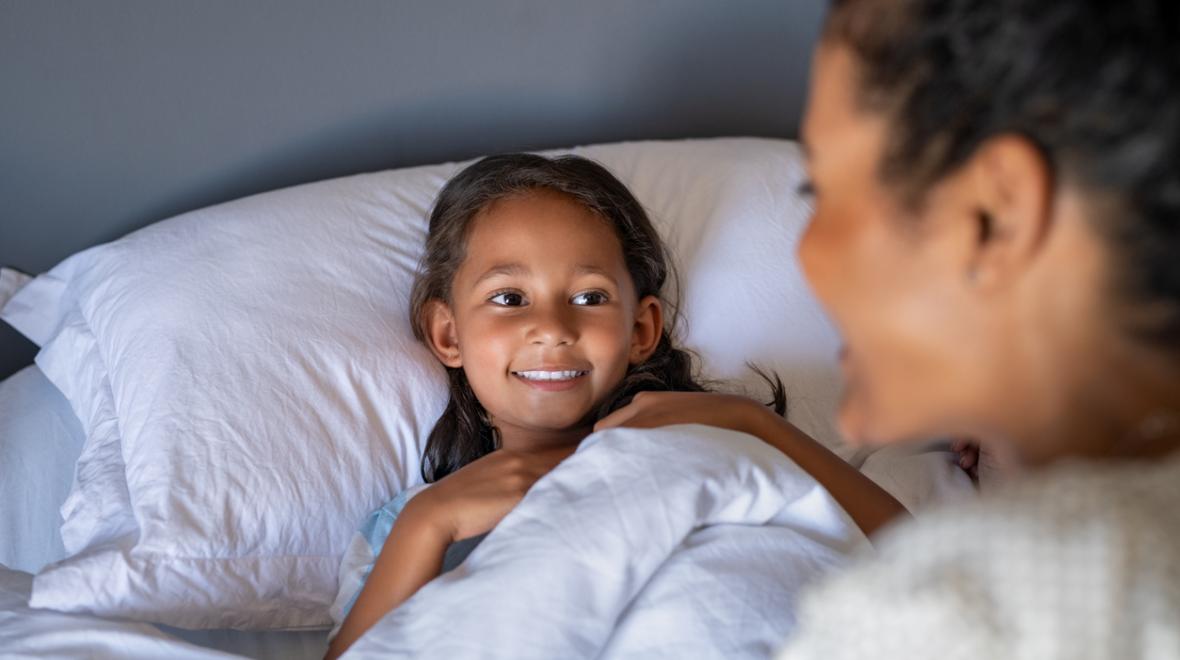
Editor's note: This article was sponsored by Seattle Children's Hospital.
By the time kids reach school age, even the hardiest of night-owl parents have learned to value a good night’s sleep. It’s a lesson many of us forgot during the year of remote schooling, leaving us in dread of the sudden switch to a rigid school schedule and a return to morning routines. But Maida Chen, M.D., associate professor of pediatrics at the University of Washington Medical School and the director of the sleep center at Seattle Children’s Hospital, says the transition back to school doesn’t have to be horrible.
Sleep hygiene
Good sleep hygiene can end bedtime battles and take the edge off the early morning rude awakening. “Sleep hygiene is creating the optimal environment for your brain and body to get the best night’s sleep possible,” she says. That starts with a cool (65–68 degrees is optimal), dark room. Blackout curtains may be necessary for kids with an early bedtime, and screen time should end up to two hours (at least 30 minutes) before lights out.
“This allows your brain to process everything that you’ve seen on the screen and it also eliminates that light trigger from the screen,” says Chen. If a child is afraid of the dark, avoid LED nightlights in favor of old-fashioned bulbs placed behind furniture — ambient light is less disruptive to sleep than direct light. Similarly, turn digital clocks away from kids while they sleep.
Silence is good, but quiet white noise can be better, because it masks the intermittent, jarring sounds that startle a drowsy child into alertness. Rambunctious play and bedtime battles also get everyone’s energy up. It’s better to spend a few extra minutes letting a kid wind down than to escalate into a showdown.
Healthy habits during the day matter, too. Eating healthy meals (and affording enough time for digestion before bed) and getting lots of exercise earlier in the day improve sleep quality as well as help kids nod off.
Back-to-school bedtime routines
“A lot of families stress about bedtimes. But even if you do nothing to prepare, the overwhelming majority of kids will figure it out, and once they’re in the school year they will adapt,” says Chen. You may experience a few cranky mornings, but no permanent damage will be done. If your goal is to avoid crankiness, treat the transition back to school like jet lag; it generally takes a day for the body to adjust for every hour’s difference. If your summer routine is way off the school schedule, incremental change is easier.
“The quickest thing is to start being much more structured with wake time,” says Chen. It’s impossible to go to bed early when you slept past noon. Getting up earlier means your child will be tired enough to sleep at night.
How much sleep is enough?
“Every kid is different. There is no one perfect bedtime,” says Chen. What’s important is being well-rested. For elementary students, that can take anywhere between nine and 12 hours. A child who is getting enough sleep will wake up easily — ideally, without an alarm clock. If your child is cranky, misbehaving or having trouble in school, there are a lot of possible causes — one of them is insufficient sleep.
Sleep needs change over time, especially at the onset of puberty. Teens naturally sleep less and at later hours than younger children. It can be hard for teens to fall asleep early enough to rest sufficiently before they have to be up for school. FOMO-driven late nights on social media exacerbate this conflict, so establishing a firm media curfew is one of the most powerful tools to ensure adequate sleep for teens. But it has to be reasonable — and it helps if we model healthy screen-use choices and habits ourselves.
“Continuous negative reinforcement is not the best approach,” warns Chen. “There’s a careful balance of independence and safety.”
Although teens often have bad judgement, early bell times are physiologically unreasonable. The American Academy of Pediatrics recommends middle and high schools start no earlier than 8:30 a.m. Chen, a veteran of the process that shifted Seattle Public Schools’ upper grades to later bell times, encourages parents to advocate for more biologically friendly school schedules.
“Not everybody has to wake up at 7 o’clock every day for us to be healthy and okay. But change has to come from families to start with. Administrators are not necessarily motivated to make those kinds of changes,” she says.
When you can’t get enough
Even if there are not enough hours in the weekday, letting kids sleep late on the weekend is not the best idea.
“When you’re sleep-deprived, it’s tempting to sleep in, but that hurts circadian rhythms,” says Chen. An extra hour on Saturday morning can be refreshing, but binge-sleeping does more harm than good. Chen advises similar restraint with naps. “Napping is a double-edged sword. I’d avoid naps unless there’s really no way to get more sleep at night.” If a kid is exhausted, a 20-minute power nap can help them get through the rest of the day. But longer naps cut into night sleep, perpetuating a cycle of insufficient sleep.
Instead, Chen recommends circling back to the mornings. Make sure kids are exposed to bright light when they get up — even using light therapy lamps — and sleep up until the last possible moment. Parents often schedule an hour or more to get ready in the morning, partly because groggy kids are slow-moving.
“A lot of it is nighttime planning to minimize what needs to be done in the morning,” says Chen. Pack backpacks and lunches; set out breakfast and clothes; even let kids sleep in their school clothes to minimize how much needs to be done in the morning. The extra 30 minutes of morning sleep are worth the effort.
What about medication?
“There is definitely a role for medication for kids who have difficulties with anxiety or ADHD, or are on the autism spectrum. But it is really important to do that under the supervision of a medical professional,” says Chen. “Anything sold in the supplements aisle will be generally safe, but it is really hard to know what dosage you are getting, and the long-term effects are largely unknown.”
Because they are regulated as food instead of drugs, teas and supplements have not been researched and tested as prescription medicines have. The concentration of active ingredients is not always accurately listed on packaging. Such sleep aids can even be counterproductive — if taken at the wrong time, melatonin can make kids groggy the next day and throw off the sleep cycles you’re trying to reinforce.
Restoring rhythm
The start of the school year is a great opportunity to hit the reset button on sleep hygiene. But that doesn’t have to mean the end of spontaneity or creating a prison of rigorous scheduling.
“Routines provide a solid ground to return to after a bumpy school year and a long summer. It’s hard to accommodate deviation and reassert normalcy when you don’t have solid ground to pivot on,” says Chen. Whatever happens this school year, healthy, regular sleep habits will help your family thrive.
Additional sleep resources |
|
Sponsored by: |












